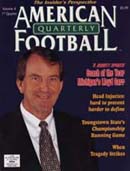AMERICAN FOOTBALL MONTHLY THE #1 RESOURCE FOR FOOTBALL COACHES
Article CategoriesAFM Magazine
|
Ducks Two-Step Punt SkillsSpecific Techniques, Skills, and Drills for the Two Step Punterby: Mike Beliotti Head Coach, University of Oregon © More from this issue For the sake of clarity we will assume the punter kicks with his right foot. To properly coach the punter you should stand directly behind or beside him on his right side. Goals: The first goal is to get the punt off. We would like the punt to be away in 2.2 seconds, have a minimum of 4.5 seconds of hang time, and travel a minimum of 40 yards. Hang time is more important than distance. A general rule of thumb is always to demand more than one second of hang time per 10 yards of punt. We utilize a spread punt formation and want our net punt to be 38 yards or better. We can not allow any punts to be blocked. Last year we averaged over 42 yards per punt, almost 38 yards net punt, and no punts blocked. Alignment: Our punter stands 15 yards directly behind the center. We tell the snapper that the aiming poi....The full article can only be seen by subscribers.
|
|
|||||||
| HOME |
MAGAZINE |
SUBSCRIBE | ONLINE COLUMNISTS | COACHING VIDEOS |
Copyright 2025, AmericanFootballMonthly.com
All Rights Reserved





